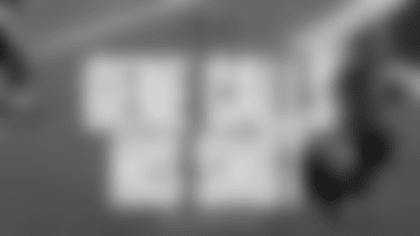What are the good folks in the football offices at One Buccaneer Place working on these days? Depends upon whether or not they've had lunch yet.
The return of actual football players to the fields behind the Tampa Bay Buccaneers headquarters is still several weeks away. Nevertheless, there has been plenty to keep the teams' coaches and personnel evaluators busy since January. Some of that work has involved looking outward, at the players who make up the free agency and draft fields. Some of it involves looking inward, and it's as important as identifying the right prospects to add to the roster. Both involve a lot of tape study.
"We do a lot of tape study," said Head Coach Dirk Koetter last week, while taking a short break from the work at One Buc to attend the NFL's Annual Meeting. "We study ourselves and all the things we talked about earlier that we need to do better. We're making teach tapes or making things to show the players. We're studying other teams."
As Koetter described it, Buccaneer coaches split their days in half from the beginning of the offseason up through the draft. The first half of the day is spent on evaluating the Bucs' strengths and weaknesses, as identifying league trends and devising a plan to prepare for them. The second half of the day, now that the big rush of free agency is over, is spent studying potential draft picks.
For obvious strategic reasons, nobody on the Bucs' staff is going to divulge many details about who they're studying during their afternoons. In contrast, Koetter was willing to share a couple of the issues that are occupying their minds and their tape machines in the morning. One is an offensive trend picking up steam around the league, the other is an area in which the Buccaneers failed to meet their goals a year ago.
"There were five teams in the league that were 60% touchdowns in the red zone; we studied those five teams," said Koetter. "We studied RPOs a lot because that's going to be a hot trend next year. So we studied all the RPO teams in the league, defense and offense."
Red zone efficiency is the more universal of those two concerns, one of those critical game situations to which every team devotes a lot of "special category" practice time. "RPO," an abbreviation for "run-pass option," was one of the NFL's most inescapable buzz terms last year. It's an offensive strategy that has been around forever, usually more prevalent at the college level, but has been more frequently used in the last couple years. The Philadelphia Eagles made it a significant part of their offense with both Carson Wentz and Nick Foles under center, and ended the season as Super Bowl champs.
Tampa Bay's quarterback, Jameis Winston, was a surprisingly effective runner as a rookie with six touchdowns but he hasn't topped 213 ground yards in any of his three seasons and ran just 33 times last year. Whether or not the Buccaneers want to build an RPO package of any significance into Winston's game, it still makes plenty of sense to study what other teams are doing with that strategy. After all, the Bucs' defense has to learn how to stop it, and they will probably run into more RPOs in 2018 than they did in 2017.
"We had a small [RPO] package, and I think everybody in the NFL was doing a tiny amount, some teams more than others," said Koetter. "I think what Philadelphia did in their run to the Super Bowl, teams [are going to emulate]. That's just the way this league works. Teams study the most successful teams. Based on what you saw Philly do and what it does to the defense, I think you're going to see more and more teams do that."
Winston isn't one of the league's swifter quarterbacks, but that may not be necessary for the Bucs to take advantage of the RPO approach to some extent. It sounds as if, at the very least, Tampa Bay's coaching staff will have it as an option in their playbook in 2018.
"We're not talking about a full-fledged spread offense here, but we're just talking about incorporating some more RPOs," said Koetter. "What that really does is it slows the back side of the defense down. It slows down the backside linebacker and it slows down the backside defensive ends. Those are some pretty outstanding athletic players, so if you can slow those guys down a little bit it does make sense."
As for red zone study, the concern is that the Buccaneers only scored touchdowns on 49.1% of their trips inside the opponent's 20-yard line in 2017. That was well below Koetter's goal, which he had recently upped from 55% to 60% after seeing a league-wide trend in better red zone production. Tampa Bay ranked 24th in red zone touchdown percentage and 26th in average points per red zone trip, at 4.34. Given that 10 of the Bucs' 16 games last year were decided by one score or less, and the Buccaneers were 3-7 in those games, every point is precious.
As Koetter noted, there were five teams that hit the red zone touchdown goal he had set for his own squad. Unsurprisingly, all four teams that made it to the conference championship games were among that group of five (the fifth was Green Bay). That means the Bucs' coaches, both offensive and defensive, are watching a lot of tape of the Eagles, Vikings, Patriots and Jaguars.
Until lunchtime, that is. After lunch, it's time to study draft prospects again.
























